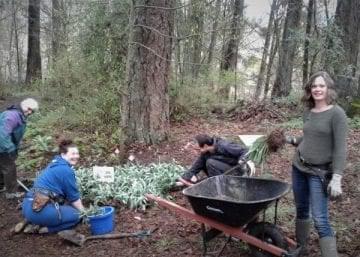Every herbalist loves dreaming about their ideal garden. Some want raised beds full of flowering angelica. Some want rambling wild rose hedges. Some want a sandy path that leads to a favorite nopal cactus for juicy pads or fruit. Where ever your dream leads you, be sure you are bringing a healing legacy with you. Plants do not acknowledge property lines and can be a problem if they move out their planned area. Below is list of sustainable gardening tips for the smart herb gardening.
- Garden Outside the Box – Many plants have wonderful medicinal properties but are not appropriate to grow in your area. Each region has its own list of invasive or undesirable plants. For example, people that live in gated communities may not be allowed to grow dandelions. To adapt, herbalists in these living conditions can find sources elsewhere in which dandelions are grown without pesticides and herbicides that they can harvest. You can increase your community connection by offering to pull dandelions in a friend’s yard for your medicine chest. Think of busy parents or elderly neighbors that would see your harvesting as weeding.
- Make Room for Natives – When you make your list of necessary plants, double check to see if any of them can be replaced with native species. Goldenseal is favorite berberine-rich antibiotic but those that live in the Pacific Northwest should opt for Oregon grape instead. Native versions are more sustainable than their non-native counterparts as they are easier to care for and feed native bird and bees which in turn help the rest of the garden flourish.
- Check with the Local Extension Service – Most counties have Extension Service volunteer groups that keep an updated list of invasive plants and a list of endangered plants. Ask what kinds of plants feed endangered animals in the areas. For example: Are you digging your garden beds in South Carolina? If you want to plant an anti-inflammatory vine like honeysuckle, choose native Trumpet Honeysuckle (Lonicera sempervirens) instead of Japenese Honeysuckle (Lonicera japonica) as local ruby-throated hummingbirds drink the nectar of the local honeysuckle but not the non-native. Even if your county doesn’t have an Extension Service, it will host a local plant-lover group. Gardeners are everywhere!
- Make a List – Stroll your neighborhood and notice which plants have escaped yards. Which herbs do you need to plant? If the woods just outside city limits have flourishing patches of cleavers or chickweed, don’t plant some in your garden. This would be a good time to exchange the convenience of having a local patch outside your door with adventure of responsible wildcrafting.
- Plant According to Need – Make your garden sustainable in accordance with your own rhythm and needs. Think about which plants you actually need and will use according to past use. A small patch of difficult to control plants like those in the mint family might be all you need for the year. Think about what your garden looked like last year when planning your plants this year. If you stopped watering them in August due to water shortages in your area, seek out plants you want that are drought tolerant. If you suffer from pollen allergies and can’t weed them in spring, pick plants that help with sinus drainage and need little attention once they are established. Plant for success.
- Be a Pot Head – Some plants are very helpful but extremely hard to control. Put your rangy plants in pots either on a patio or sink the pots into the ground to control the plants ability to spread by roots such as with comfrey. Diligently trim the blossoms and bring them inside as flower arrangements instead of letting them go to seed. When you move, dig up questionable plants to bring with you or give them to herbalist friends who are also sworn to plant stewardship. Don’t assume that the next renter will be as careful as you are.
- Look Into the Future – How big is this plant going to be? Planting a hawthorn tree may give you a basket of haw fruits now or it may shade your tomato plants every summer for after the first 5 years. After a hawthorn tree is in the ground, it is very difficult to dig up. Are you thinking of planting a ginkgo tree instead? Do you want a male or a female tree? Male trees may have pollen that trigger sinus congestion in the spring but female trees have smelly fruit to clean up in the fall. Think ahead about how these plants might influence your life and those of your neighbors in the years to come.
Once you figure out how to balance these basic tips, you will have a beautiful and sustainable garden that will be a joy to work in for years to come. Happy Gardening!







